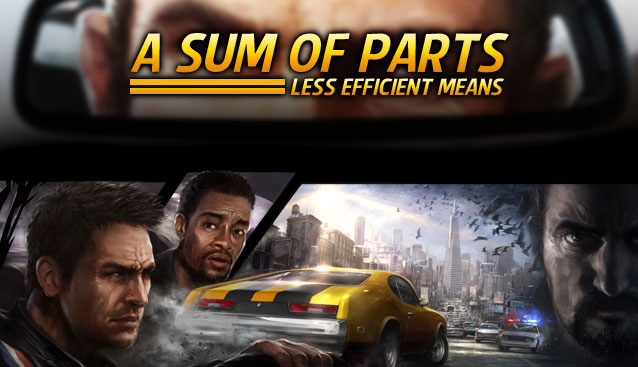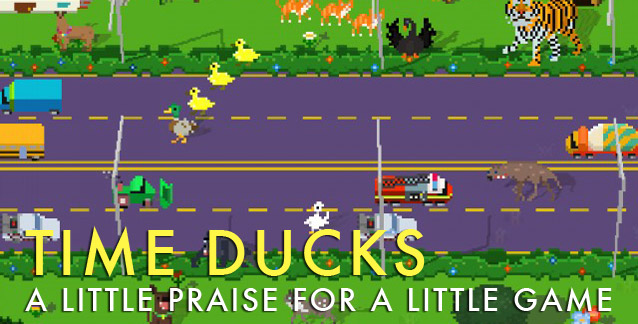


Often, when I write about a game, there are so many different things I want to say about it. So many specific, detailed, disparate features and moments worthy of focus get skimmed over as I end up writing about broader themes or systems. It’s understandable: when you only have 500 or so words to say something about a game, you are going to inevitably move towards the abstract. This column aims to rectify that by spending multiple articles looking at a single game, to focus on multiple specific elements rather than the entire game as a singular whole. I might look at a specific object or level, a certain character or plot point, or a particular mechanic or theme. The focus will be on the specifics.
To start with, this month I will be looking at the tragically under-appreciated Driver: San Francisco. Like many people, I ignored Driver: SF when it came out late last year. It is not a franchise I have cared about for many, many years; there were too many other releases I was interested in late last year; and, most crucially, the hook of the entire game taking place inside of a dream turned me off.
Which is kind of ironic because once I finally played Driver: SF, I realised that is precisely because it takes place in a dream that the game is so fascinating. At first, the dream seems to be just an excuse for the game’s central ‘shifting’ mechanic, which allows protagonist Tanner to ‘shift’ into the body of the driver of any other vehicle in the city (like Grand Theft Auto without the intervening legwork). But the dreamscape of the city becomes so much more fundamental to the entire experience.
I have written elsewhere about how the fact the world is a dream justifies all the weird logic-holes inherent to any videogame world, about how all videogames are dream-like. Things that wouldn’t usually make sense do make sense specifically because this is a dream. It allows Driver: SF to do all kinds of weird, unconventional, one-off things that most AAA games, obsessed as they are with realism, could never get away with.
But what’s just as fascinating as how Driver SF shows how videogames are dreamlike, is how it shows how dreams are gamelike. Tanner dreams up goals and obstacles. He dreams up a game. In his sleep, he becomes a game designer.
Lying there in his hospital bed, he plays out his obsession of catching Jericho in his head.I am not a big fan of definitions of what a game ‘is’. Frankly, I think such definitions do more damage to good criticism than they are useful. That said, in Bernard Suit’s 1978 book The Grasshopper, Suits has some interesting musings on just this topic. After many pages, Suits decides on a definition of game that states (in part) that “playing a game is the voluntary attempt to overcome unnecessary obstacles” and also notes that in a game “rules prohibit efficient means in favour of less efficient means.”
Take golf, for example. The easiest way to obtain the goal of the ball ending up in the hole would be to pick up the ball, walk over to the hole, and place the ball inside. But if we did that, not only would we be cheating, we wouldn’t even actually be playing golf; we would be doing something else entirely. Instead, we take the less efficient (and often infuriating) path of hitting that ball around with a stick.
At the start of Driver SF, Tanner is obsessed with putting Jericho behind bars. It is partially because of this obsession that he ends up in the car crash that puts him in a coma in the first place. Lying there in his hospital bed, he plays out his obsession of catching Jericho in his head.
But he doesn’t just dream of catching Jericho. He dreams of trying to catch Jericho and Jericho always just slipping away, always being just out of reach. Even with his new powers, Tanner can’t just simply find Jericho. He keeps putting obstacles in his way.
When a game takes place in a dream, the player in inevitably going to ask questions. “Isn’t it a bit convenient that I can shift into the bodies of everyone around the car I am trying to stop, but not the driver of that car itself?”
It’s something Tanner’s partner, Jones, brings up often. “Why don’t you just shift into that guy?” he’ll ask, almost acting as the player’s mouthpiece. Tanner just shakes his head, frustrated, “It doesn’t work that way.”
Tanner has designed a game in his dream, a game with goals and less-efficient means by which to obtain them. Shifting right into the guy you are chasing is too efficient. If Tanner did that, he wouldn’t be playing the game he has designed for himself in his own head. It doesn’t work that way.
As the game/dream progresses, Tanner throws bigger and bigger challenges at himself. He makes Jericho more powerful. At the same time, Tanner makes his own abilities more powerful, too, but only just powerful enough to keep his goals just unobtainable.
I’m no psychoanalyst, but it seems to me that dreams are often actually like this. The most simplest of goals can be utterly unobtainable, forever just of out reach. They can be frustrating and terrifying—perhaps even more often than they are wish-fulfilling. When we play videogames, we enter a dreamlike world. When we dream, we enter a gamelike world. We give ourselves means by which to obtain the goals, and whenever we get close the goal changes again. We play out our obsessions, but that doesn’t mean we fulfil them. To do that, we need to wake up.




 Destiny Limited vs. Guardian vs. Ghost Edition Comparison
Destiny Limited vs. Guardian vs. Ghost Edition Comparison Dead Rising 2 Guide
Dead Rising 2 Guide super smash bros for 3ds and wii u challenge unlockables walkthrough and wiki guide
super smash bros for 3ds and wii u challenge unlockables walkthrough and wiki guide Kingston HyperX Cloud Headset Review
Kingston HyperX Cloud Headset Review Elvis Presley: Here his best records 80 years after his birth
Elvis Presley: Here his best records 80 years after his birth